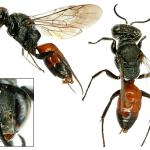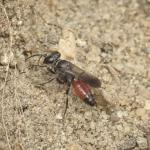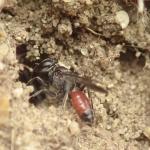A revised key to the now three British species of Miscophus has been published by Knowles and Else (2005). M. bicolor generally has a greater extent of orange-red coloration on the gaster than M. concolor, with additional differences in the wing venation and propodeal sculpturing. On average, M. bicolor is the largest of the three British species.
References
Bitsch, J., Dollfuss, H., Bouček, Z., Schmidt, K., Schmid-Egger, C., Gayubo, S.F., Antropov, A.V. & Barbier, Y. 2001. Hyménoptères Sphecidae D’Europe Occidentale Vol. 3. Faune de France, France et Régions Limitrophes 86: 1-459.
Dollfuss, H. 1991. Bestimmungsschlüssel der Grabwespen Nord- und Zentraleuropas (Hymenoptera, Sphecidae) mit speziellen Angaben zur Grabwespenfauna Oesterreichs. Stapfia 24: 1-247.
Knowles, A.P. and Else, G.R. 2005. Miscophus bicolor Jurine (Hymenoptera: Crabronidae), a wasp new to Britain. British Journal of Entomology and Natural History 18: 229-232
This wasp was discovered new to Britain in 2003, when it was found at Maidscross Hill near Lakenheath in north-west Suffolk. Since then, it has been found at several sites across north Suffolk, from Breckland in the north-west to the Blyth estuary near the east coast. In 2022 it was added to the Norfolk list and is currently known from four sites in VC West Norfolk (T. Strudwick, pers. comm.). Notably, on 18th July 2024, Tim Strudwick recorded several from dunes at Burnham Overy Staithe on the north Norfolk coast, representing a huge expansion in its known range.
The NHML has specimens of M. bicolor from France, Spain, Austria, Switzerland, Greece, Cyprus, Israel, Turkey, Bulgaria and Sicily. Bitsch et al. (2001) add Iran, Syria and Kazakhstan, whilst Dollfuss (1991) notes its presence also in North Africa, from Algeria. Bitsch et al. show the species to be quite widely distributed across France, but it would appear that this species is, if native to Britain, at the extreme north-western edge of its range in Europe.
As a new British species, this wasp has yet to be assigned a status. It is evidently spreading so would not appear to be of immediate conservation concern.
Until 2024, all sites comprised acid grassland and/or heathland habitats. In July 2024, Tim Strudwick found this wasp on bare eroded areas fringing a path along the landward edge of dune grassland on the Norfolk coast. Ground disturbance is a frequent feature, including the presence of a motocross course, the slopes of old sand pits, the fringes of rabbit burrows and well-trodden paths. It has been observed hunting for prey amongst the veil of roots and small spider webs that hang down where sandy soil has been eroded from below turf, forming small vertical faces a few inches high.
The very limited British data set covers the period early July to early September. Dollfuss (1991) suggests June until September for north and central Europe.
The genus as a whole preys on small spiders. Very little information is available concerning prey in Britain. In 2024 Hawk Honey (pers.comm.) intercepted a wasp with a specimen of Asagena phalerata (Arachnida, Araneae).
Its nesting behaviour appears to focus on relatively steep, sparsely vegetated banks, but little detailed information is available. In the field, its behaviour, size and appearance are very similar to that of Tachysphex pompiliformis, which would inhabit similar nesting places. This makes gathering observational information difficult.
Not known.
No data available.
2024




